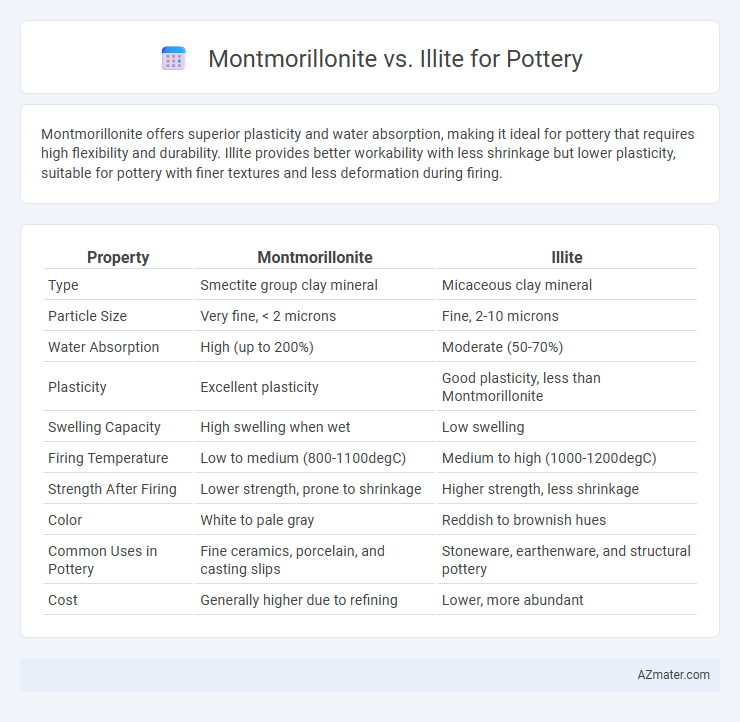Montmorillonite offers superior plasticity and water absorption, making it ideal for pottery that requires high flexibility and durability. Illite provides better workability with less shrinkage but lower plasticity, suitable for pottery with finer textures and less deformation during firing.
Table of Comparison
| Property | Montmorillonite | Illite |
|---|---|---|
| Type | Smectite group clay mineral | Micaceous clay mineral |
| Particle Size | Very fine, < 2 microns | Fine, 2-10 microns |
| Water Absorption | High (up to 200%) | Moderate (50-70%) |
| Plasticity | Excellent plasticity | Good plasticity, less than Montmorillonite |
| Swelling Capacity | High swelling when wet | Low swelling |
| Firing Temperature | Low to medium (800-1100degC) | Medium to high (1000-1200degC) |
| Strength After Firing | Lower strength, prone to shrinkage | Higher strength, less shrinkage |
| Color | White to pale gray | Reddish to brownish hues |
| Common Uses in Pottery | Fine ceramics, porcelain, and casting slips | Stoneware, earthenware, and structural pottery |
| Cost | Generally higher due to refining | Lower, more abundant |
Introduction to Montmorillonite and Illite
Montmorillonite and Illite are two clay minerals commonly used in pottery, each with distinct properties that affect the workability and final texture of ceramic products. Montmorillonite, a type of smectite clay, is known for its high swelling capacity and plasticity, which improves moldability and water retention during shaping. Illite, a non-expanding clay mineral, offers better structural stability and reduces shrinkage, making it ideal for creating more durable and less porous pottery.
Chemical Composition of Montmorillonite vs Illite
Montmorillonite is a smectite clay mineral characterized by a high content of expandable layers, primarily composed of hydrated sodium calcium aluminum magnesium silicates. Illite, a non-expanding mica-like clay, contains higher amounts of potassium and aluminum with a chemical formula generally rich in K, Al, and Si, but lacks significant swelling capacity. The chemical composition difference influences pottery properties, as montmorillonite's higher magnesium and exchangeable cations improve plasticity and water retention, whereas illite provides more structural stability and less shrinkage during firing.
Physical Properties Relevant to Pottery
Montmorillonite features high plasticity and swelling capacity, making it ideal for pottery that requires flexibility and workability during shaping. Illite exhibits lower plasticity with a more granular texture, providing better drying strength but reduced malleability. The particle size and water absorption of montmorillonite contribute to smoother, more elastic clay bodies, while illite enhances durability and resistance to cracking during firing.
Plasticity and Workability in Clay Bodies
Montmorillonite offers superior plasticity in pottery clay bodies due to its fine particle size and high water absorption, allowing for greater flexibility and ease of shaping. Illite, with coarser particles and lower swelling capacity, provides moderate plasticity but improves drying strength and reduces shrinkage during firing. Combining montmorillonite and illite balances workability and structural stability, enhancing the overall performance of ceramic materials.
Firing Temperatures and Thermal Behavior
Montmorillonite clay exhibits a lower firing temperature, typically between 900degC and 1100degC, with significant shrinkage and increased plasticity during firing, making it suitable for earthenware pottery. Illite clay fires at higher temperatures, ranging from 1050degC to 1300degC, offering enhanced thermal stability and reduced shrinkage, ideal for stoneware ceramics. The thermal behavior of montmorillonite is characterized by greater water absorption and expansion, while illite provides better resistance to thermal shock and durability in finished pottery.
Color and Texture After Firing
Montmorillonite clay produces pottery with a smoother texture and tends to fire to a lighter, creamier color, offering a fine, plastic quality ideal for detailed work. Illite clay, containing less swelling capacity, results in a firmer texture and typically yields pottery with warmer, reddish or brown hues after firing due to its higher iron content. The color and surface finish differences between Montmorillonite and Illite clays are critical for potters seeking specific aesthetic and tactile properties in their ceramics.
Impact on Glaze Interaction
Montmorillonite's high swelling capacity and reactive surface area enhance glaze adhesion and promote uniform melting during firing, resulting in smoother, more durable finishes. Illite, with its lower plasticity and reduced swelling, offers less interaction with glazes, often leading to thinner glaze walls and potential for uneven coverage. The choice between montmorillonite and illite significantly influences glaze behavior, affecting both aesthetic and functional properties of ceramic wares.
Durability and Strength of Finished Pottery
Montmorillonite clay, known for its high plasticity and swelling properties, often results in pottery with excellent strength but lower durability due to its tendency to expand and contract with moisture changes. Illite clay, characterized by its moderate plasticity and finer particle structure, produces pottery that is more durable and resistant to cracking yet may have slightly less tensile strength compared to montmorillonite-based ceramics. Selecting illite-rich clay bodies enhances the longevity and structural integrity of finished pottery, making it ideal for functional ware exposed to variable environmental conditions.
Availability and Sourcing for Potters
Montmorillonite is widely available in volcanic ash and bentonite clay deposits, making it a popular choice for potters seeking plasticity and workability. Illite, found predominantly in sedimentary rocks and shale formations, is less abundant but valued for its resistance to shrinking and cracking during firing. Sourcing Montmorillonite is typically easier due to its global deposits, whereas Illite requires more region-specific mining, affecting its accessibility for pottery production.
Choosing the Right Clay for Your Pottery Project
Montmorillonite clay offers excellent plasticity and high water absorption, making it ideal for pottery projects requiring smooth shaping and fine detail. Illite clay features a coarser texture with less shrinkage, providing greater durability and better resistance to cracking during firing. Selecting between Montmorillonite and Illite depends on the desired balance of workability versus strength in your final pottery piece.

Infographic: Montmorillonite vs Illite for Pottery
 azmater.com
azmater.com